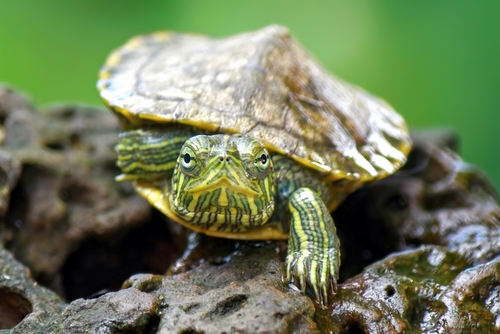Red Eared Sliders are one of the most popular turtle species kept as pets. They are easy to take care of, have a long lifespan, and are very active.
However, they can get lonely in their tanks which is why many pet owners opt to put other species in with them.
In this blog post, we will discuss the 15 best red eared slider tank mates that are compatible with these friendly turtles.
Contents
What you need to know
If you’re considering adding tank mates to your red-eared slider’s aquarium, make sure that the species you choose are compatible with the turtles and won’t pose a threat to them.
Additionally, ensure that the tank size and water conditions are appropriate for all inhabitants. Red-eared sliders are social creatures and benefit from having companions in their tanks.
Red Eared Slider Tank Mates
You will also like these other top picks in this category:
1. African Dwarf Frogs:

- Scientific Name: Hymenochirus
- Adult Size: 2.5″
- Compatible with: Guppies, Corys, Tetras
- Care Level: Medium to hard
- Origin: Equatorial Africa
These small aquatic frogs are perfect tank mates for red-eared sliders. They are small enough not to be seen as food, and their movement and color add a great visual aspect to the aquarium.
African Dwarf frogs are social creatures as well, so it’s best to keep them in groups of two or more. They are easy to care for and can live up to five years. However, it’s important to note that these little ones are not strong swimmers and prefer calm waters.
Make sure the filtration system in your tank is not too strong, and provide plenty of places for the frogs to rest, such as floating plants or pieces of driftwood.
2. Guppies:

- Scientific Name: Poecilia reticulata
- Adult Size: 1 to 2 inches
- Compatible with: mollies, platies, neon tetras
- Care Level: easy
- Origin: northeast South America
Guppies are small and colorful fish that are a great addition to a red-eared slider’s tank. They are easy to care for and add a great pop of color to the aquarium.
Guppies are peaceful and won’t harm the turtles, but it’s important to note that they are small enough to be seen as food by the turtles if they are not well-fed. To prevent this, make sure you feed your turtles a balanced diet and supplement their diet with commercial turtle food.
3. Goldfish:

- Scientific Name: Carassius auratus
- Adult Size: 6 to 8 inches (15 to 20 centimeters)
- Compatible with: peaceful coldwater fish species such as White Cloud Mountain Minnows, Rosy Barbs, and Weather Loaches.
- Care Level: Moderate
- Origin: East Asia
Goldfish are a common tank mate for red-eared sliders. They are hardy and can tolerate the same water conditions as the turtles. However, it’s important to note that goldfish can grow quite large, so make sure you have a big enough tank.
It’s important to remember that goldfish can be carriers of parasites and diseases that can infect your red-eared slider. To prevent this, make sure you quarantine any new goldfish before adding them to the tank.
Goldfish are opportunistic feeders and will eat anything that fits in their mouths, including red-eared slider eggs and hatchlings. To prevent this, make sure your turtles are well-fed and that any new goldfish are of a similar size to the turtles.
4. Corydoras Catfish:
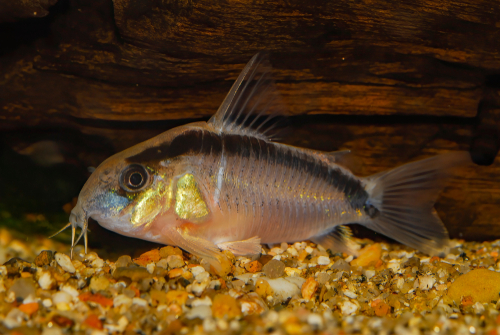
- Scientific Name: Corydoras
- Adult Size: 1 to 4 inches
- Compatible with: swordtails, mollies, guppies, and tetras
- Care Level: easy
- Origin: freshwater bodies in South America
These are bottom-dwelling fish that are compatible with red-eared sliders. They are peaceful and add a great visual aspect to the tank.
These fish have delicate barbels, which can be damaged by rough substrate or sharp decorations. To prevent injury, make sure the substrate in your tank is smooth and free of any sharp edges. Corydoras catfish are social creatures and should be kept in groups of six or more.
They are also scavengers and will eat any food that reaches the bottom of the tank. To prevent competition with the turtles, make sure the food you give your corydoras catfish sinks quickly and that your turtles are fed separately.
5. Platy Fish:
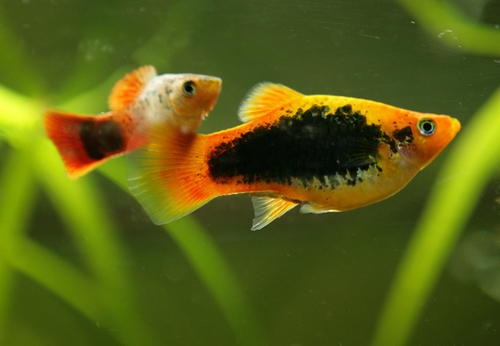
- Scientific Name: Xiphophorus maculatus
- Adult Size: up to 3 inches
- Compatible with: small tetras, corydoras, tetras, rainbowfish
- Care Level: easy
- Origin: Central and South America
Another colorful fish species that can coexist with red-eared sliders is platyfish. They are easy to care for and can withstand a wide range of water conditions.
It’s important to note that platy fish can be aggressive toward one another if they are not kept in a large enough group. To prevent aggression, make sure you keep at least three platy fish together. They can also be carriers of parasites and diseases that can infect your red-eared slider. To prevent this, make sure you quarantine any new platy fish before adding them to the tank.
They are also opportunistic feeders and will eat anything that fits in their mouths, including red-eared slider eggs and hatchlings. To prevent this, make sure your turtles are well-fed and that any new platyfish are of a similar size to the turtles.
6. Bearded Dragons:
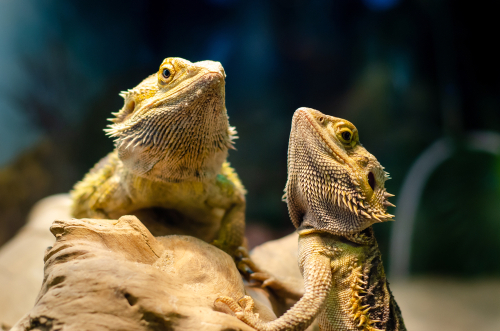
- Scientific Name: Pogona spp
- Adult Size: 18 to 22 inches (45 to 56 centimeters)
- Compatible with: Turtles, lizards, tortoises
- Care Level: intermediate care levels
- Origin: Australia
Bearded dragons are a great reptile companion for red-eared sliders. They are calm and docile and won’t bother the turtles. Bearded dragons require a basking spot with temperatures higher than what is suitable for red-eared sliders.
Make sure to provide a separate basking area for your bearded dragon and monitor the temperature closely to ensure it’s not too hot for your turtles.
Bearded dragons are omnivores and require a varied diet that includes insects and vegetables. Provide a balanced diet for your bearded dragon and monitor their feeding to prevent competition with the turtles.
7. Leopard Geckos:
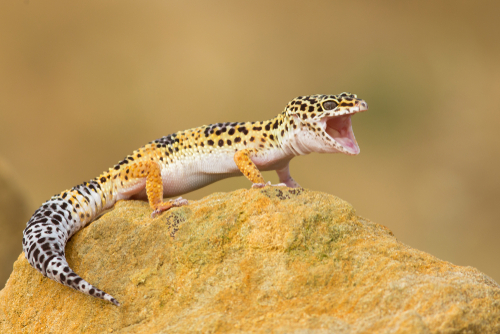
- Scientific Name: Eublepharis macularius
- Adult Size: 7 to 10 inches (18 to 25 centimeters)
- Compatible with: Other geckos, reptiles & turtles
- Care Level: easy
- Origin: regions of South Asia, including Afghanistan, Pakistan, and parts of India
Leopard geckos are a popular pet reptile that can coexist with red-eared sliders. They are easy to care for and won’t pose a threat to the turtles.
This reptile is nocturnal and prefers to be active at night, which makes them a great companion for red-eared sliders that are more active during the day. Leopard geckos are insectivores and require a diet consisting of insects.
8. Green Anoles:

- Scientific Name: Anolis carolinensis
- Adult Size: 6 to 8 inches (15 to 20 centimeters)
- Compatible with: turtles & reptiles
- Care Level: moderate
- Origin: southeastern United States
They are a small lizard species that can be kept with red-eared sliders. They are active and add a great visual aspect to the tank.
These lizards are arboreal and require plenty of vertical space in their enclosure. While they are not aggressive towards red-eared sliders, it’s important to ensure that the turtles are not able to reach the anoles’ enclosure and harm them. Green anoles also require a basking spot and a diet consisting of insects.
9. Freshwater Clams:
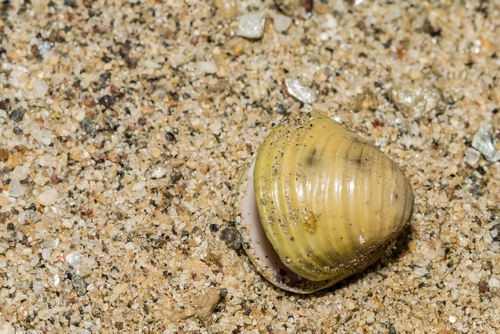
- Scientific Name: Corbicula fluminea
- Adult Size: 1 to 2 inches (2.5 to 5 centimeters)
- Compatible with: platies, guppies, tetras, snails and peaceful community aquarium
- Care Level: easy
- Origin: Asia
They are a great addition to a red-eared slider’s tank. They help keep the water clean and add a unique visual aspect to the aquarium. These clams are filter feeders, meaning they extract food particles and organic matter from the water to survive.
In doing so, they help to keep the water clean by removing excess nutrients and other waste products. Freshwater clams are also relatively easy to care for and can live for several years.
10. Ghost Shrimp:
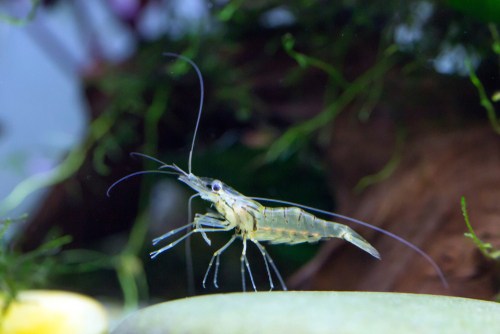
- Scientific Name: Palaemonetes paludosus
- Adult Size: 1.5″
- Compatible with: Cherry Shrimp, Corys, Kuhli Loach
- Care Level: Easy
- Origin: North America (Appalachian Mountain area)
These are small invertebrates that can coexist with red-eared sliders. They are peaceful and won’t bother the turtles. They are scavengers and will help keep the tank clean by eating any food that falls to the bottom of the tank. They are relatively easy to care for and can live for several years.
Ghost shrimp can be sensitive to changes in water quality and can be harmed by high levels of ammonia, nitrites, and nitrates. Make sure to perform regular water changes and monitor the water parameters closely to ensure they stay within acceptable levels.
11. Apple Snails:
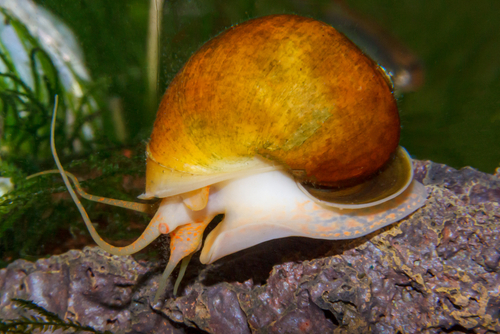
- Scientific Name: Pomacea diffusa
- Adult Size: 1.5 to 2 inches (3.8 to 5 centimeters)
- Compatible with: Cherry Shrimp, Corys, Kuhli Loach platies, guppies, tetras, snails and peaceful community aquarium
- Care Level: easy
- Origin: South America
Apple snails are a popular invertebrate that can be kept with red-eared sliders. They help keep the tank clean and add a great visual aspect to the aquarium.
Apple snails are herbivores and won’t compete for the same food as the turtles. However, they can be harmed by aggressive tank mates, such as large fish or turtles. Make sure to choose compatible tank mates and monitor their behavior closely to ensure they don’t harm the snails.
12. Cherry Shrimp:

- Scientific Name: Neocaridina davidi
- Adult Size: 1 to 1.5 inches (2.5 to 3.8 centimeters)
- Compatible with: Cherry Shrimp, Corys, Kuhli Loach platies, guppies, tetras, snails and peaceful community aquarium
- Care Level: easy
- Origin: Taiwan and Southern China
Another invertebrate species that can coexist with red-eared sliders that are easy to care for and add a great pop of color to the tank. They are peaceful, but they are small enough to be seen as food by the turtles if they are not well-fed. To prevent this, make sure you feed your turtles a balanced diet.
13. Nerite Snails:
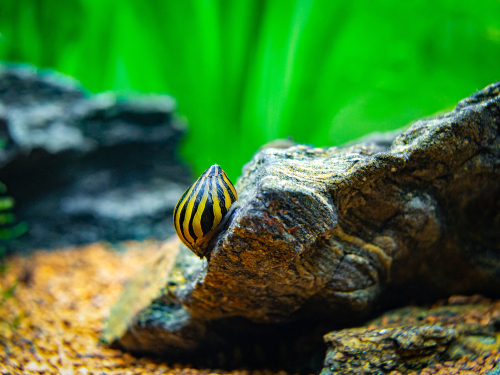
- Scientific Name: Nerita
- Adult Size: 1″
- Compatible with: cichlids, barbs, and tetras
- Care Level: Easy
- Origin: Kenya, South Africa, Mozambique
They are a great invertebrate companion for red-eared sliders. They help keep the tank clean and add a unique visual aspect to the aquarium.
Nerite snails are excellent algae eaters, which helps keep the tank clean and reduces the amount of maintenance required.
Summary
Red-eared sliders are social creatures and benefit from having companions in their tanks. The above list outlines the 15 best tank mates for red-eared sliders that are compatible with these friendly turtles. Remember to always make sure the tank size and water conditions are suitable for all the species in the tank.
Frequently Asked Questions
Can red-eared sliders be kept with other turtle species?
Red-eared sliders can be kept with other turtle species as long as they are of similar size and temperament. However, it’s important to provide enough space and resources for all the turtles in the tank.
How many tank mates can I add to my red-eared slider’s tank?
The number of tank mates you can add to your red-eared slider’s tank depends on the size of the tank and the size and needs of the species you want to add. Always research the species you want to add and make sure the tank size and water conditions are suitable for all the inhabitants.
Can red-eared sliders be kept with invertebrates?
Red-eared sliders can be kept with certain invertebrate species, such as freshwater clams and ghost shrimp, as long as they are not aggressive and won’t harm the turtles.

Ian Sterling, founder of Fishlab.com, began his aquarium journey over 30 years ago, driven by a deep fascination for fish and their diverse personalities. His website, Fishlab.com, is dedicated to making fishkeeping accessible and enjoyable, offering beginner-friendly guidance, expert insights, and a community for aquarists to connect and share experiences.


